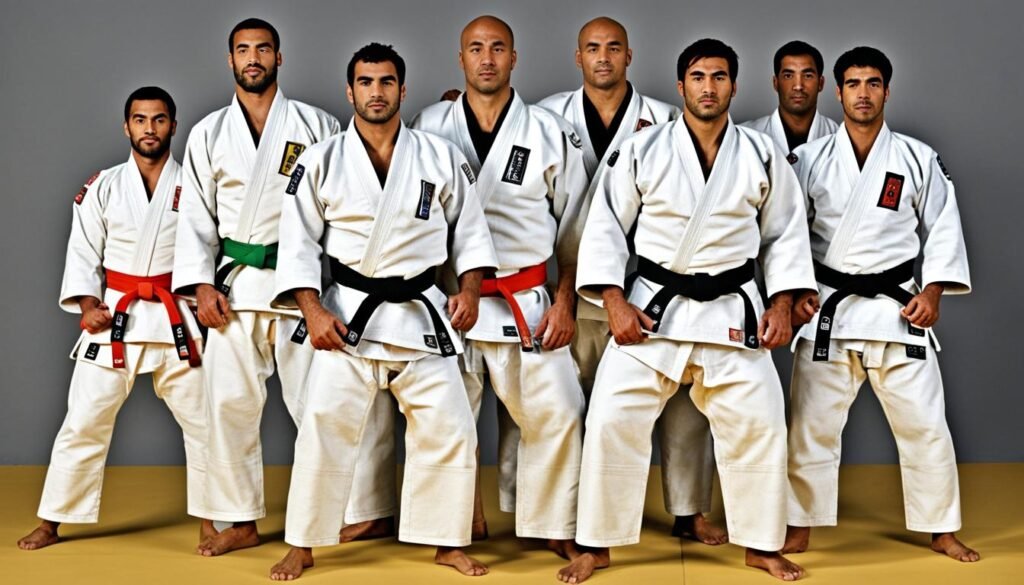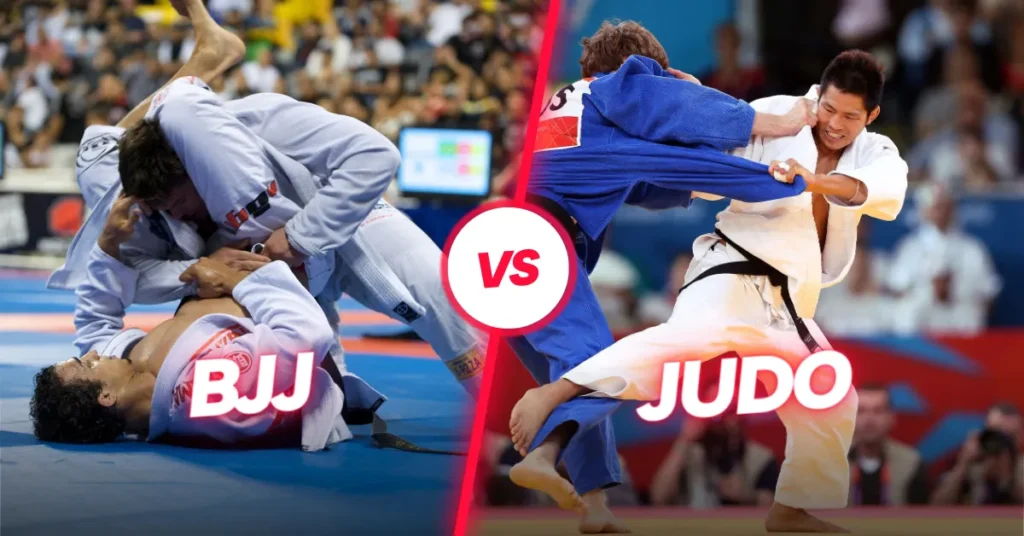Judo belts play a pivotal role in the sport, not only as a visual representation but also as a symbol of rank and expertise. The colors of the belts signify the wearer’s progress and skill level, indicating their dedication and experience in the art of judo.
Understanding the judo belt system is essential for both beginners and experienced practitioners. In this comprehensive judo belt guide, we will explore the various aspects of judo belts, including their colors, ranking, and significance within the sport.
Table of Contents
Key Takeaways
- The judo belt system signifies rank and expertise levels in the martial art.
- The colors of judo belts represent different ranks and levels of proficiency.
- Understanding judo belt significance helps judokas track their progress and set goals.
- The belt system was introduced by Professor Jigoro Kano, the founder of judo.
- Judo belts are a visual indicator of a practitioner’s growth in the sport.
The History and Meaning of Judo Belts
The use of belts in martial arts, including judo, dates back to the early days of the sport. Professor Jigoro Kano introduced the belt system to signify rank and level of expertise in judo. The belts were inspired by the Menkyo reward method from the 16th century, which used certificates to recognize the achievements and skills of practitioners.
The colors of judo belts represent different stages of learning and development. The white belt symbolizes purity and signifies the beginning of the judoka’s journey in the martial art. As the judoka progresses and gains proficiency, they move through various belt colors, demonstrating their growth and dedication to the sport. Finally, the black belt represents expertise and mastery, symbolizing the culmination of years of training and experience.
The origin of judo belts can be traced back to Professor Kano’s desire to provide a visual representation of each judoka’s progress and level of skill. Each color belt holds its own significance and carries a special meaning within the judo community. Understanding the history and meaning behind the judo belt system is essential for practitioners to fully appreciate their achievements and strive for continual improvement.
The Progression of Judo Belts
Judo belts follow a progressive ranking system, with each color representing a different level of skill and experience. Beginners start with a white belt and as they gain proficiency, they progress to yellow, orange, green, blue, brown, and finally, black belt.
The transition from one belt to another is not solely based on time but also on the judoka’s demonstration of technique, knowledge, and adherence to moral principles. It is a reflection of their growth and dedication to the martial art. Advancement through the belt levels requires consistent training, learning, and improvement.
Once a judoka reaches the coveted black belt, their progression does not end. The black belt is often seen as a significant milestone, but it is just the beginning of a new journey. Beyond the black belt, judokas can continue to advance through the Dan ranks, which signify higher levels of expertise.
Each Dan rank represents a further refinement of techniques and an increased understanding of the philosophy of judo. The progression through the Dan ranks requires not only technical proficiency but also a deep commitment to personal growth, the development of character, and the spread of judo principles.
This progression system provides judokas with clear goals and a sense of accomplishment as they work their way through the different belt levels. It creates a structured pathway for growth and allows practitioners to continually challenge themselves and strive for excellence.
Ranking System in Judo:
| Belt Color | Rank |
|---|---|
| White | Beginner – 6th Kyu |
| Yellow | 5th Kyu |
| Orange | 4th Kyu |
| Green | 3th Kyu |
| Blue | 2th Kyu |
| Brown | 1st Kyu |
| Black | 1st Dan onwards |
Note: The above ranking system may vary slightly depending on the country or martial arts federation.

Choosing the Right Judo Belt
When it comes to judo, selecting the right belt is essential, particularly for beginners. Several factors should be taken into account to ensure the perfect choice. One of the first considerations is the judoka’s skill level. Beginners typically start with a white or yellow belt, while more advanced practitioners progress to higher-level belts, symbolizing their growth and experience in the martial art.
Aside from skill level, martial arts goals should also be considered in the belt selection process. Some judokas may have specific objectives, such as competition participation or attaining a black belt. These aspirations may influence the type of belt they choose, as each belt carries its own meaning and represents different milestones on the judoka’s journey.
Budget is another aspect that deserves attention. Judo belts come in various materials, including cotton and silk. While cotton belts are more common and affordable, silk belts are usually reserved for higher-level practitioners. Judokas should consider their financial situation and invest in a belt that suits both their budget and their long-term goals in judo.
Moreover, it is important to mention that the regulations regarding belt colors may differ among countries and martial arts federations. Judokas must be aware of these regulations to ensure their belt aligns with the standards set by the governing bodies. Compliance with these guidelines not only maintains the integrity of the sport but also fosters a sense of unity among judoka worldwide.
Ultimately, choosing the right judo belt is a decision that reflects a judoka’s individual journey and aspirations in the martial art. By considering factors such as skill level, martial arts goals, budget, and regulations, practitioners can make an informed choice that aligns with their needs and symbolizes their commitment to the sport.
How to tie your Belt
Judo Belt Guide
Each color of the judo belt holds its own significance and reflects the judoka’s progress and skill level. Understanding the symbolism behind each color helps judokas appreciate the significance of their achievements.
White belt (6th kyu):
The white belt is the starting point for all judo students. It symbolizes purity and the beginning of the learning process.

Buddy23Lee and Spoxjox, CC BY-SA 3.0 https://creativecommons.org/licenses/by-sa/3.0, via Wikimedia Commons
Yellow belt (5th kyu):
The yellow belt represents the first steps in the student’s understanding of judo. It signifies the dawning of knowledge.

Original rastor graphicSpoxjoxDerived vector artJdcollins13, CC BY-SA 3.0 https://creativecommons.org/licenses/by-sa/3.0, via Wikimedia Commons
Orange belt (4th kyu):
The orange belt indicates that the student has made progress and is building a strong foundation in judo techniques.

Original rastor graphicSpoxjoxDerived vector artJdcollins13, CC BY-SA 3.0 https://creativecommons.org/licenses/by-sa/3.0, via Wikimedia Commons
Green belt (3rd kyu):
This belt represents growth and development in the student’s judo skills. It signifies the progress towards maturity in the art.

Rhaym-tech2004, CC BY-SA 4.0 https://creativecommons.org/licenses/by-sa/4.0, via Wikimedia Commons
Blue belt (2nd kyu):
The blue belt signifies the deepening of the student’s knowledge and proficiency in judo. It represents the sky, towards which the student is reaching.

Original rastor graphicSpoxjoxDerived vector artJdcollins13, CC BY-SA 3.0 https://creativecommons.org/licenses/by-sa/3.0, via Wikimedia Commons
Brown belt (1st kyu):
The brown belt indicates the ripening and maturing of the student’s skills in judo. It is a sign of the student’s journey towards black belt proficiency.

Original rastor graphicSpoxjoxDerived vector artJdcollins13, CC BY-SA 3.0 https://creativecommons.org/licenses/by-sa/3.0, via Wikimedia Commons
Black belt (1st dan):
The black belt, the pinnacle of the judo belt system, represents mastery in the sport. It signifies that the practitioner has attained a high level of proficiency and technical skill. However, it’s important to note that the learning never truly ends, even at this level. Black belts continue to strive for improvement and refinement, embodying the principles of judo both on and off the mats.

Original: Grook Da Oger Vector: Jdcollins13, CC BY-SA 3.0 https://creativecommons.org/licenses/by-sa/3.0, via Wikimedia Commons
The Colors In Between
The colors between the white and black belts, such as yellow, orange, green, blue, and brown, signify different stages of learning and development. Each color represents a milestone achieved by the judoka and acts as a visual indicator of progress. As the judoka advances through each level, they acquire new skills and deepen their understanding of judo.
These belt colors also serve as a source of motivation and inspiration for judokas, reminding them of their progress and the goals they strive to achieve. Each promotion to a new belt color symbolizes growth, improvement, and the dedication put into mastering the techniques and principles of judo.
By understanding the significance of judo belt colors, judokas gain a deeper appreciation for their own journey and the journey of those around them. The belt system not only provides a path for progression but also fosters a sense of community and camaraderie among judoka of all levels.

Conclusion
Judo belts are an integral part of the martial art, signifying a judoka’s progress, dedication, and skill. The belt system in judo provides practitioners with a clear path to track their advancement and set goals for further development. By understanding the meaning behind each belt color and embracing the significance of judo belts, judokas can fully immerse themselves in the spirit of judo and continue to evolve in their practice.
Choosing the right judo belt is crucial for every judoka, as it reflects their skill level and aligns with their martial arts goals. Factors such as the judoka’s proficiency, budget, and adherence to regulations should be considered when selecting a belt. Beginners typically start with a white or yellow belt, while advanced practitioners progress to higher-level belts symbolizing their expertise and mastery.
In summary, judo belts serve as visual indicators of a judoka’s journey, representing their growth and commitment to the martial art. Understanding the significance of each belt color encourages practitioners to strive for higher ranks and continuously improve their techniques and knowledge. The judo belt system fosters discipline, goal-setting, and the pursuit of excellence, making it an essential aspect of the judo practice.
FAQ
What do judo belts represent?
Judo belts represent the wearer’s rank and level of expertise in the martial art.
Who introduced the belt system in judo?
The belt system in judo was introduced by Professor Jigoro Kano, the founder of judo.
How many grades are there in judo?
Judo has a total of 10 dan grades. The dan grades represent the higher levels of proficiency and experience in the art of judo. The progression from kyū to dan grades is an essential aspect of the judo ranking system, symbolizing a practitioner’s growth and understanding of the martial art.
What do the colors of judo belts signify?
The colors of judo belts represent different ranks and levels within the sport.
How do I choose the right judo belt?
Factors to consider when choosing a judo belt include the judoka’s skill level, martial arts goals, and budget.
What is the order of belts in judo?
The order of belts in judo follows a progression of colored belts, representing different kyū grades. The typical order is white, yellow, orange, green, blue, brown, and black. The black belt, specifically the 1st dan, signifies a practitioner who has attained a certain level of competence. Each colored belt represents a stage of skill development and understanding of the art.
What is the significance of judo belt colors?
Each color of the judo belt holds its own significance and reflects the judoka’s progress and skill level.
How many ranks are there in judo?
Judo has a system of ranks divided into kyū and dan grades. Kyū grades are marked by colored belts, while dan grades are indicated by black belts. There are a total of 10 dan levels in judo, with the highest being the 10th dan.
How does the progression of judo belts work?
Judo belts follow a progressive ranking system, with each color representing a different level of skill and experience.
What are the levels of judo?
Judo levels are categorized into two main groups: kyū grades and dan grades. Kyū grades are the colored belts, and practitioners progress through these ranks before reaching the black belt, which indicates the dan grades. The dan grades, signified by black belts, range from 1st dan to 10th dan, representing increasing levels of expertise and mastery in judo.



